您好,登录后才能下订单哦!
对数字货币的崛起感到新奇的我们,并且想知道其背后的技术——区块链是怎样实现的。

但是完全搞懂区块链并非易事,我喜欢在实践中学习,通过写代码来学习技术会掌握得更牢固。通过构建一个区块链可以加深对区块链的理解。
准备工作
本文要求读者对Python有基本的理解,能读写基本的Python,并且需要对HTTP请求有基本的了解。
我们知道区块链是由区块的记录构成的不可变、有序的链结构,记录可以是交易、文件或任何你想要的数据,重要的是它们是通过哈希值(hashes)链接起来的。
环境准备
环境准备,确保已经安装Python3.5, pip , django, requests,urllib,json,hashlib
安装方法:
pip install django requests
同时还需要一个HTTP客户端,比如Postman,cURL或其它客户端,本文以Postman为例。
开始创建Blockchain
通过django-admin startproject block创建一个block的项目,在项目中创建一个demo项目django-admin startproject demo ,目录结构:
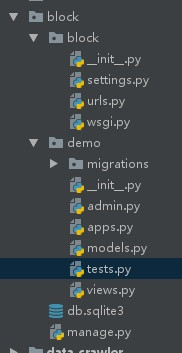
Blockchain类
在views中创建一个Blockchain类,在构造函数中创建了两个列表,一个用于储存区块链,一个用于储存交易。
以下是Blockchain类的框架:
class Blockchain(object):
def __init__(self):
self.chain = []
self.current_transactions = []
def new_block(self):
# Creates a new Block and adds it to the chain
pass
def new_transaction(self):
# Adds a new transaction to the list of transactions
pass
@staticmethod
def hash(block):
# Hashes a Block
pass
@property
def last_block(self):
# Returns the last Block in the chain
pass
Blockchain类用来管理链条,它能存储交易,加入新块等,下面我们来进一步完善这些方法。
块结构
每个区块包含属性:索引(index),Unix时间戳(timestamp),交易列表(transactions),工作量证明(稍后解释)以及前一个区块的Hash值。
以下是一个区块的结构:
block = {
'index': 1,
'timestamp': 1506057125.900785,
'transactions': [
{
'sender': "8527147fe1f5426f9dd545de4b27ee00",
'recipient': "a77f5cdfa2934df3954a5c7c7da5df1f",
'amount': 5,
}
],
'proof': 324984774000,
'previous_hash': "2cf24dba5fb0a30e26e83b2ac5b9e29e1b161e5c1fa7425e73043362938b9824"
}
到这里,区块链的概念就清楚了,每个新的区块都包含上一个区块的Hash,这是关键的一点,它保障了区块链不可变性。如果攻击者破坏了前面的某个区块,那么后面所有区块的Hash都会变得不正确。不理解的话,慢慢消化,可参考区块链记账原理
加入交易
接下来我们需要添加一个交易,来完善下new_transaction方法
class Blockchain(object):
...
def new_transaction(self, sender, recipient, amount):
"""
生成新交易信息,信息将加入到下一个待挖的区块中
:param sender: <str> Address of the Sender
:param recipient: <str> Address of the Recipient
:param amount: <int> Amount
:return: <int> The index of the Block that will hold this transaction
"""
self.current_transactions.append({
'sender': sender,
'recipient': recipient,
'amount': amount,
})
return self.last_block['index'] + 1
方法向列表中添加一个交易记录,并返回该记录将被添加到的区块(下一个待挖掘的区块)的索引,等下在用户提交交易时会有用。
创建新块
当Blockchain实例化后,我们需要构造一个创世块(没有前区块的第一个区块),并且给它加上一个工作量证明。
每个区块都需要经过工作量证明,俗称挖矿,稍后会继续讲解。
为了构造创世块,我们还需要完善new_block(), new_transaction() 和hash() 方法:
class Blockchain(object):
def __init__(self):
self.chain = []
self.current_transactions = []
self.new_block(previous_hash=1, proof=100)
self.nodes = set()
def new_block(self,proof,previous_hash= None):
block = {
'index': len(self.chain) + 1,
'timestamp': time(),
'transactions': self.current_transactions,
'proof':proof ,
'previous_hash': previous_hash or self.hash(self.chain[-1]),
}
self.current_transactions = []
self.chain.append(block)
return block
def new_transaction(self,sender,recipient,amount):
self.current_transactions.append({
'sender': sender,
'recipient': recipient,
'amount': amount,
})
return self.last_block['index']+1
@staticmethod
def hash(block):
block_string = json.dumps(block, sort_keys=True).encode()
return hashlib.sha256(block_string).hexdigest()
通过上面的代码和注释可以对区块链有直观的了解,接下来我们看看区块是怎么挖出来的。
理解工作量证明
新的区块依赖工作量证明算法(PoW)来构造。PoW的目标是找出一个符合特定条件的数字, 这个数字很难计算出来,但容易验证 。这就是工作量证明的核心思想。
为了方便理解,举个例子:
假设一个整数 x 乘以另一个整数 y 的积的 Hash 值必须以 0 结尾,即 hash(x * y) = ac23dc…0。设变量 x = 5,求 y 的值?
用Python实现如下:
from hashlib import sha256 x = 5 y = 0 while sha256(str(x*y).encode()).hexdigest()[:4] != "0000": y += 1 print(y,sha256(str(x*y).encode()).hexdigest()[:4]) print(y)
在比特币中,使用称为Hashcash的工作量证明算法,它和上面的问题很类似。矿工们为了争夺创建区块的权利而争相计算结果。通常,计算难度与目标字符串需要满足的特定字符的数量成正比,矿工算出结果后,会获得比特币奖励。
当然,在网络上非常容易验证这个结果。
实现工作量证明
让我们来实现一个相似PoW算法,规则是:寻找一个数 p,使得它与前一个区块的 proof 拼接成的字符串的 Hash 值以 4 个零开头。
import hashlib
import json
from time import time
from uuid import uuid4
class Blockchain(object):
...
def last_block(self):
return self.chain[-1]
def proof_of_work(self, last_proof):
proof = 0
while self.valid_proof(last_proof, proof) is False:
proof += 1
return proof
@staticmethod
def valid_proof(last_proof, proof):
guess = str(last_proof*proof).encode()
guess_hash = hashlib.sha256(guess).hexdigest()
return guess_hash[:5] == "00000"
衡量算法复杂度的办法是修改零开头的个数。使用4个来用于演示,你会发现多一个零都会大大增加计算出结果所需的时间。
现在Blockchain类基本已经完成了,接下来使用HTTP requests来进行交互。
Blockchain作为API接口
我们将使用Python django框架,这是一个轻量Web应用框架,它方便将网络请求映射到 Python函数,现在我们来让来试一下:
我们将创建三个接口:
/transactions/new 创建一个交易并添加到区块 /mine 告诉服务器去挖掘新的区块 /chain 返回整个区块链
创建节点
我们的“django web服务器”将扮演区块链网络中的一个节点。我们先添加一些框架代码:
node_identifier = str(uuid4()).replace('-', '')
# Instantiate the Blockchain
blockchain = Blockchain()
def mine(request):
last_block = blockchain.last_block
last_proof = last_block['proof']
proof = blockchain.proof_of_work(last_proof)
print(proof)
blockchain.new_transaction(
sender="0",
recipient=node_identifier,
amount=1,
)
# Forge the new Block by adding it to the chain
block = blockchain.new_block(proof)
response = {
'message': "New Block Forged",
'index': block['index'],
'transactions': block['transactions'],
'proof': block['proof'],
'previous_hash': block['previous_hash'],
}
print(response)
return HttpResponse(json.dumps(response))
def new_transaction(request):
values = json.loads(request.body.decode('utf-8'))
required = ['sender', 'recipient', 'amount']
if not all(k in values for k in required):
return 'Missing values'
index = blockchain.new_transaction(values['sender'], values['recipient'], values['amount'])
print(index)
response = {'message': 'Transaction will be added to Block %s'%index}
return HttpResponse(json.dumps(response))
def full_chain(request):
response = {
'chain': blockchain.chain,
'length': len(blockchain.chain),
}
return HttpResponse(json.dumps(response))
添加url路由节点:运行服务
from demo import views urlpatterns = [ url(r'^admin/', admin.site.urls), url(r'^mine', views.mine), url(r'^transactions/new/', views.new_transaction), url(r'^chain/', views.full_chain), url(r'^register', views.register_nodes), url(r'^resolve', views.consensus), ]
运行服务
python manage.py runserver 127.0.0.1:8000
发送交易
发送到节点的交易数据,结构如下:
{
"sender": "my address",
"recipient": "someone else's address",
"amount": 5
}
向服务添加一个交易
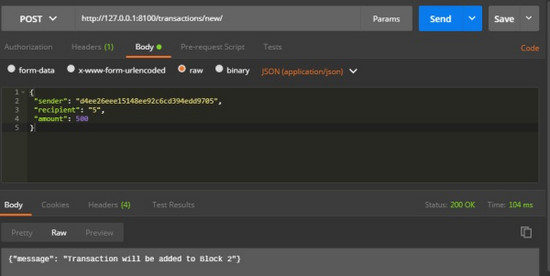
挖矿
挖矿正是神奇所在,它很简单,做了一下三件事:
计算工作量证明PoW
通过新增一个交易授予矿工(自己)一个币
构造新区块并将其添加到链中
def proof_of_work(self, last_proof):
proof = 0
while self.valid_proof(last_proof, proof) is False:
proof += 1
return proof
@staticmethod
def valid_proof(last_proof, proof):
guess = str(last_proof*proof).encode()
guess_hash = hashlib.sha256(guess).hexdigest()
return guess_hash[:5] == "00000"
注意交易的接收者是我们自己的服务器节点,我们做的大部分工作都只是围绕Blockchain类方法进行交互。到此,我们的区块链就算完成了,我们来实际运行下
运行区块链
你可以使用cURL 或Postman 去和API进行交互
让我们通过请求 http://127.0.0.1:8000/mine 来进行挖矿
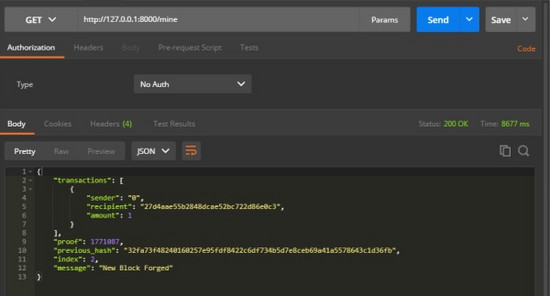
在挖了两次矿之后,就有3个块了,通过请求 http://localhost:8000/chain 可以得到所有的块信息。
{ "chain": [
{
"transactions": [],
"proof": 100,
"timestamp": 1520314374.7261052,
"index": 1,
"previous_hash": 1
},
{
"transactions": [
{
"sender": "0",
"recipient": "27d4aae55b2848dcae52bc722d86e0c3",
"amount": 1
}
],
"proof": 1771087,
"timestamp": 1520314389.5019505,
"index": 2,
"previous_hash": "32fa73f48240160257e95fdf8422c6df734b5d7e8ceb69a41a5578643c1d36fb"
},
{
"transactions": [
{
"sender": "d4ee26eee15148ee92c6cd394edd9705",
"recipient": "5",
"amount": 500
},
{
"sender": "0",
"recipient": "27d4aae55b2848dcae52bc722d86e0c3",
"amount": 1
}
],
"proof": 100,
"timestamp": 1520314592.4745598,
"index": 3,
"previous_hash": "e6b1be488e0ed20fe3ec51135e5fafb4dfffaa28a190967106a5dd3e89e4b3aa"
}
],
"length": 3
}
一致性(共识)
我们已经有了一个基本的区块链可以接受交易和挖矿。但是区块链系统应该是分布式的。既然是分布式的,那么我们究竟拿什么保证所有节点有同样的链呢?这就是一致性问题,我们要想在网络上有多个节点,就必须实现一个一致性的算法。
注册节点
在实现一致性算法之前,我们需要找到一种方式让一个节点知道它相邻的节点。每个节点都需要保存一份包含网络中其它节点的记录。因此让我们新增几个接口:
/register 接收URL形式的新节点列表 /resolve 执行一致性算法,解决任何冲突,确保节点拥有正确的链
我们修改下Blockchain的init函数并提供一个注册节点方法:
from urllib.parse import urlparse
...
class Blockchain(object):
def __init__(self):
...
self.nodes = set()
...
def register_node(self, address):
parsed_url = urlparse(address)
self.nodes.add(parsed_url.netloc)
我们用 set 来储存节点,这是一种避免重复添加节点的简单方法。
实现共识算法
前面提到,冲突是指不同的节点拥有不同的链,为了解决这个问题,规定最长的、有效的链才是最终的链,换句话说,网络中有效最长链才是实际的链。
我们使用一下的算法,来达到网络中的共识
class Blockchain(object):
def __init__(self):
...
def valid_chain(self, chain):
last_block = chain[0]
current_index = 1
while current_index < len(chain):
block = chain[current_index]
if block['previous_hash'] != self.hash(last_block):
return False
# Check that the Proof of Work is correct
if not self.valid_proof(last_block['proof'], block['proof']):
return False
last_block = block
current_index += 1
return True
def resolve_conflicts(self):
neighbours = self.nodes
new_chain = None
max_length = len(self.chain)
for node in neighbours:
response = requests.get('http://%s/chain' %node)
if response.status_code == 200:
length = json.loads(response)['length']
chain = json.loads(response)['chain']
# Check if the length is longer and the chain is valid
if length > max_length and self.valid_chain(chain):
max_length = length
new_chain = chain
# Replace our chain if we discovered a new, valid chain longer than ours
if new_chain:
self.chain = new_chain
return True
return False
第一个方法 valid_chain() 用来检查是否是有效链,遍历每个块验证hash和proof.
第2个方法 resolve_conflicts() 用来解决冲突,遍历所有的邻居节点,并用上一个方法检查链的有效性, 如果发现有效更长链,就替换掉自己的链
在url中添加两个路由,一个用来注册节点,一个用来解决冲突。
from demo import views urlpatterns = [ url(r'^register', views.register_nodes), url(r'^resolve', views.consensus), ]
你可以在不同的机器运行节点,或在一台机机开启不同的网络端口来模拟多节点的网络,这里在同一台机器开启不同的端口演示,在不同的终端运行一下命令,就启动了两个节点: http://127.0.0.1:8000 和 http://127.0.0.1:8100
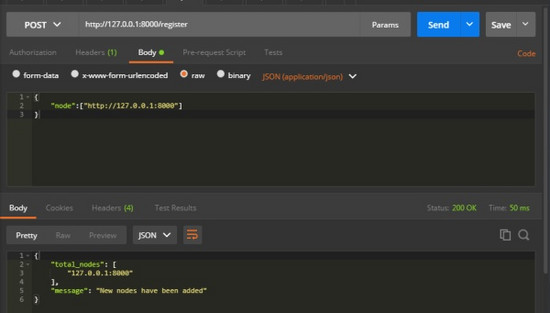
然后在节点8100节点上挖两个块,确保是更长的链,然后在节点8000节点上访问接口/resolve ,这时节点8100的链会通过共识算法被节点8000节点的链取代。
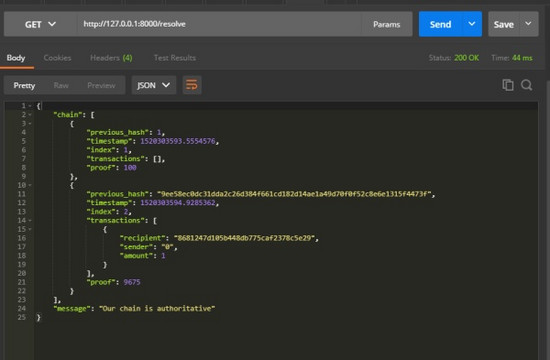
总结
以上所述是小编给大家介绍的用Django实现一个可运行的区块链应用,希望对大家有所帮助,如果大家有任何疑问请给我留言,小编会及时回复大家的。在此也非常感谢大家对亿速云网站的支持!
免责声明:本站发布的内容(图片、视频和文字)以原创、转载和分享为主,文章观点不代表本网站立场,如果涉及侵权请联系站长邮箱:is@yisu.com进行举报,并提供相关证据,一经查实,将立刻删除涉嫌侵权内容。